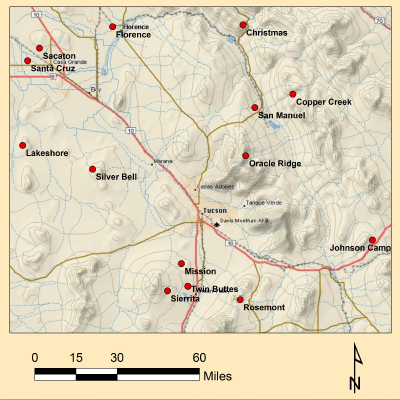

On August 12, 2014, Redhawk Resources, Inc. announced that it had entered into a binding letter of agreement with Anglo American with respect to forming a joint venture on Redhawk’s Copper Creek project, located in the Galiuro Mountains approximately 45 miles northeast of Tucson, Arizona.
According to the terms of this agreement, Anglo American can earn a 60% interest in the property by funding expenditures of $44 million over a five year period with a commitment to spend at least $3 million during the first year. Anglo America was also granted an option to increase their interest in the project from 60% to 80% by funding an additional $20 million in expenditures on or before the seventh anniversary of the effective date of this joint venture.
Copper Creek is a porphyry copper deposit that is located in the Bunker Hill mining district. Originally organized around 1883, the district’s first recorded production occurred at the Old Reliable mine and several other small deposits around 1903. The largest of the early producers was the Childs Aldwinkle mine, where the Arizona Molybdenum Corporation produced approximately 329,000 tons of copper/molybdenum ore between 1933 and 1939.
Although a modest-sized, copper resource was discovered at depth in American Eagle Basin by Newmont in 1966, much of the exploration within the district since the mid-1970s has been focused on shallow targets related to more than 400 breccia pipes that occur throughout this area. This widespread occurrence of breccia pipes has always intrigued geologists, who have speculated that a larger resource is likely present at depth.
Since 2005, exploration drilling conducted by Redhawk Resources has confirmed the presence of a large deep porphyry copper resource at Copper Creek. This work also recognized that the ores of this deposit are typical of “early-halo” type porphyry copper systems, which have been recognized in major copper districts worldwide. Other examples of early-halo porphyry copper deposits include Butte in Montana, Chuquicamata in Chile and the Highland Valley deposit in British Columbia.
To date, only five percent of the Copper Creek property has been adequately explored for its mineral potential. Evidence indicates that the tenor of the copper mineralization increases with depth. With funding provided by Anglo American, one of the world’s largest mining companies, the potential for substantially expanding the known resource at Copper Creek is very good.
Arizona is mining friendly and has a rich copper mining history. We understand the importance of mining and its role in maintaining a vibrant economy and strong national security. The great concentration of major copper deposits in this region has made Tucson the “Copper Mining Capital of North America”. It has good infrastructure including rail, roads, water, power and numerous businesses, who provide goods and services to the region’s mines. Arizona’s mining professionals have worked very hard to ensure existing and future mining projects are developed and operated in an environmentally responsible manner.
Arizona’s business community welcomes Anglo American to our area. We are looking forward to a long and prosperous relationship with the newest member of Arizona’s copper industry.
Copyright (2014) by David F. Briggs. Reprint is permitted only if the credit of authorship is provided and linked back to the source.
